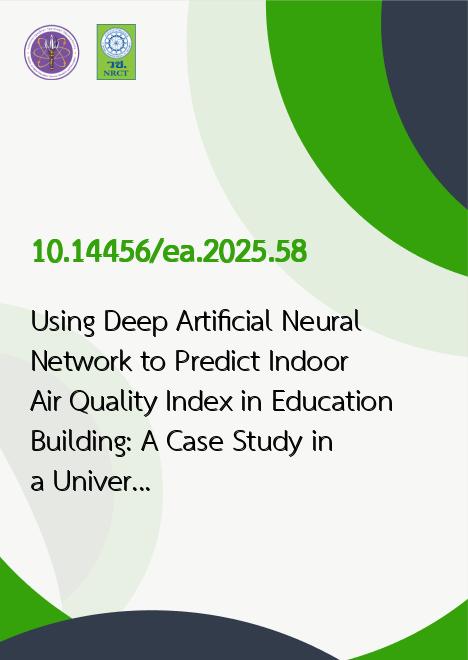
|
Using Deep Artificial Neural Network to Predict Indoor Air Quality Index in Education Building: A Case Study in a University in Pathumthani, Thailand |
|---|---|
| รหัสดีโอไอ | |
| Creator | Arroon Ketsakorn |
| Title | Using Deep Artificial Neural Network to Predict Indoor Air Quality Index in Education Building: A Case Study in a University in Pathumthani, Thailand |
| Contributor | Muhammad Ali Haider, Arroon Ketsakorn |
| Publisher | Thai Society of Higher Education Institutes on Environment |
| Publication Year | 2568 |
| Journal Title | EnvironmentAsia |
| Journal Vol. | 18 |
| Journal No. | 3 |
| Page no. | 146-157 |
| Keyword | Deep artificial neural network, Indoor air quality, Education building, Indoor airquality index, Outdoor air pollution |
| URL Website | http://www.tshe.org/ea/index.html |
| Website title | EnvironmentAsia |
| ISSN | 1906-1714 |
| Abstract | Indoor air quality (IAQ) plays a critical role in educational environments, where students spend extended periods in enclosed classrooms. Poor IAQ has been associated with sick building syndrome, respiratory ailments, and diminished academic performance. While outdoor air quality has been extensively studied, limited research has focused on predicting the Indoor Air Quality Index (IAQI) based on outdoor air parameters. This study aimed to develop and validate a deep artificial neural network (ANN) model to predict IAQI in educational buildings using outdoor air pollutant data. A field study was conducted from June to September 2024 in four classrooms within an educational facility in Pathumthani, Thailand. Indoor and outdoor air quality parameters were measured using calibrated instruments: Aeroqual AQM 64, Particle Count PC-4000, GASMET GT5000, and Q-TRAK Model 7575. Monitored pollutants included PM1, PM2.5, PM10, CO2, CO, NOx, O3, TVOCs, temperature, relative humidity, and air change rate. Measurements were recorded at 5-minute intervals during working hours, generating 240 data points per room (n = 960). A multilayer perceptron deep ANN was developed using WEKA software. Datasets were partitioned into training (70%) and testing (30%) subsets. Model architectures comprised 3 – 4 input variables, 2 hidden layers with 1 – 10 nodes, and a single output layer. Training was performed over 100,000 epochs with learning rates ranging from 0.05 to 0.5. IAQI was computed following the U.S. EPA methodology, and model accuracy was assessed using the Mean Absolute Percentage Error (MAPE). Pearson correlation analysis indicated significant associations between outdoor pollutants and IAQI, with room-specific predictor variations. The developed ANN models exhibited excellent predictive performance, achieving MAPE values between 0.21% and 0.64%, far below the 10% threshold for high accuracy. These findings support the application of deep ANN models as efficient and accurate tools for IAQI prediction in educational settings. |